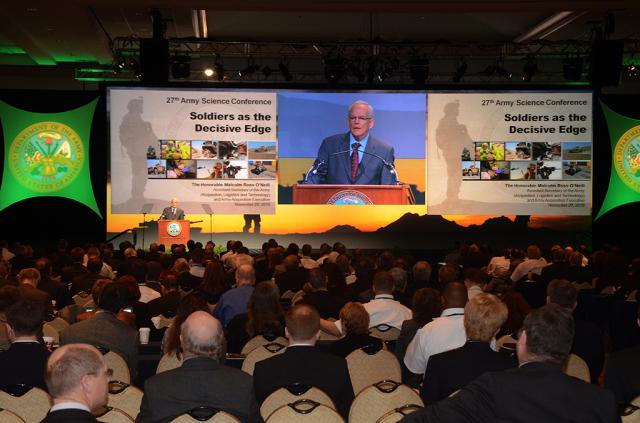The Army science and technology community has unveiled a new engagement strategy which seeks to further collaboration and dialogue with its laboratory, academic and industry partners by articulating a host of relevant S&T challenges in need of specific solutions.
As part of this effort, the Army is asking its many partners to team together to develop particular capabilities tailored to address one of seven “Big Army Problem” areas broken down into 24 specific S&T challenges emerging from the last ten years of war.
The challenges span a wide range of combat-relevant areas such as creating common software, lightening the load Soldiers carry, improving intelligence, surveillance and reconnaissance and making advances in Soldier protections.
The seven problem areas include force protection, maneuverability, human cognition, surprise/tactical intelligence, sustainability/logistics, overburdened, and tactical overmatch.
“Not only will Army S&T be involved in delivering technological advances, but we’re going to talk in terms of capabilities, which means we are going to be partners with the operational community, acquisition community and industry in identifying the capabilities that we can actually put forward,” said Marilyn Freeman, deputy assistant secretary of the Army for research and technology.
Freeman said the S&T community is looking for specifics and particular metrics in some cases to establish initial benchmarks from which to make progress.
“These challenges are identified in terms of the results we would like to see in the fiscal year 2017 timeframe, or earlier, if ready. That is not to say that we are going to stop there, but it is to give us a stake in the ground, a point at which to focus,” Freeman said.
For example, force protection challenges are broken up into Soldier and small unit, platform and basing categories. Soldier and small unit challenges in this area are described as a need to formulate an S&T program to increase the level of individual protection for male and female Soldiers at reduced total weight and volume, while enabling increased physical and mental agility.
New capabilities developed there will strive to reach identifiable metrics such as achieving a reduction in the total weight of individual protective gear by 30-to-50-percent, while simultaneously optimizing the level of protection against known and anticipated threats.
“The focus is on capabilities, not individual technologies,” Freeman said. “How do we bring those technologies together to achieve new capability? We can get together as communities to understand what these capabilities mean, what are the concepts we can come up with to address these capabilities, and how are we going to get them from whatever stage of maturity those concepts and technologies are — to where they need to be to get out in to the hands of Soldiers.”
One of the challenges in the area of surprise/tactical intelligence is identified as a “mission command,” wherein small units lack the tools to execute MC on the move and synchronize their actions. One of the key goals of this challenge is to reduce the timeline needed to develop, accredit and field intuitive, useful, effective mission command and battlefield awareness software applications.
Another of the surprise/tactical intelligence challenges is described as a need to improve “actionable intelligence.” The problem is that small units do not have sufficient capability to send and receive critical tactical intelligence.
This is described as a need for the tools or training to help Soldiers identify friends or foes, to know where IEDs are, to see inside buildings and around corners or over hills and achieve an awareness of cultural patterns that might indicate imminent danger.
Among the near-term objectives sought after for this challenge is the need to provide timely, accurate and actionable intelligence to obtain a significant reduction in unanticipated threat encounters.
A key challenge in the area of sustainability/logistics is explained as a “transport, distribute and dispose,” problem. The Army needs improved capability to tactically transport and reliably deliver consumables to forward operating bases and smaller satellite bases in remote, dispersed, austere locations with reduced supplier and equipment risk, including improved efficient and safe methods for disposing waste.
The Army S&T community aims to inspire its laboratories, academic partners at research institutions, and business associates in industry, to team together as part of a broader effort to develop capabilities able to solve these problems and challenges.
“What I’ve asked the Army S&T community to do is to take each one of these challenges and bring back a proposal for each one of these,” Freeman said. “I would like industry to examine these same challenges and tell us what they have in their pipeline that they have already been working on that they believe can be significant contributors to making these things something we can not only address, but solve.”
Freeman said the Army hopes that its industry partners might choose to spend some of their Independent Research and Development funds to develop capabilities to meet the identified challenges.
The Army is also planning to release broad agency announcements to industry as a way to articulate these challenges. It is an effort which could lead to the allocation of portions of the congressionally approved “rapid innovation funds” identified for small business in amounts up to $3 million.
“The overarching emphasis is for the first time in a long time we have a set of Army leadership validated priorities for S&T to work on,” Freeman said. “This is a brand new Army S&T strategic direction. This is a change in culture of how we have been viewed in S&T and where our value is.”










